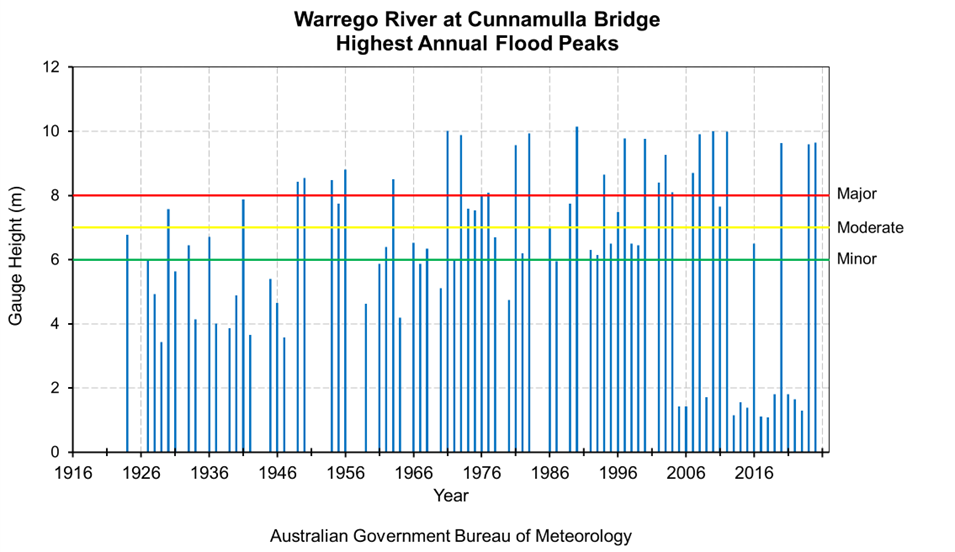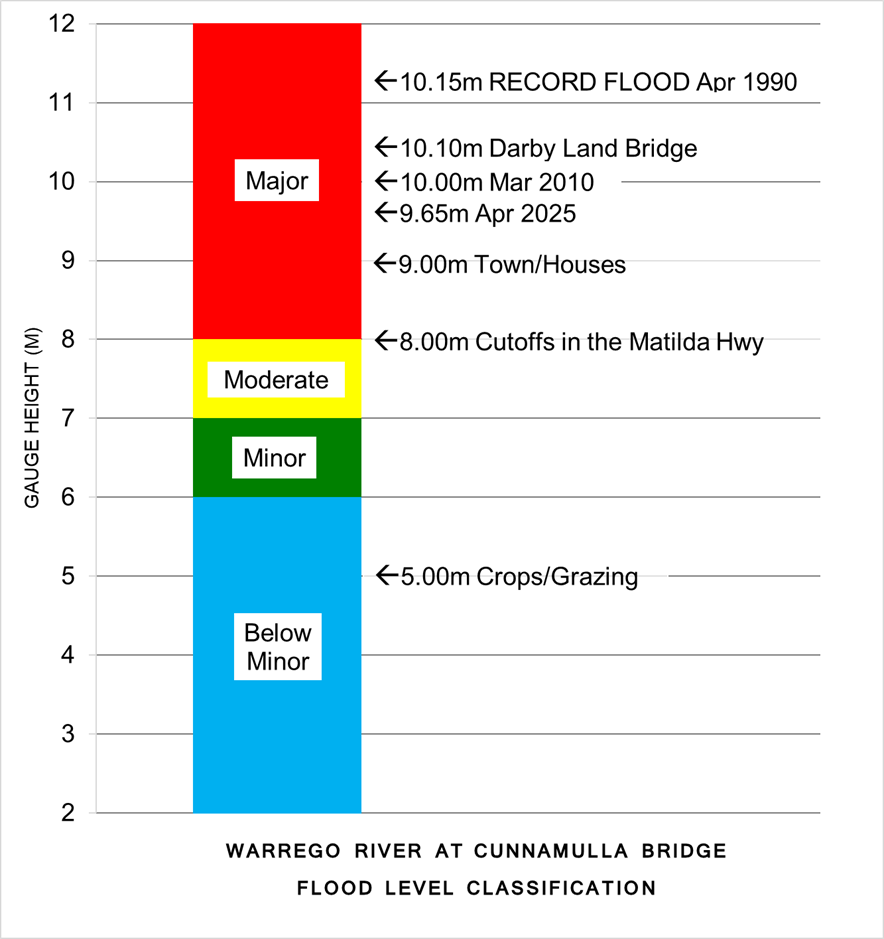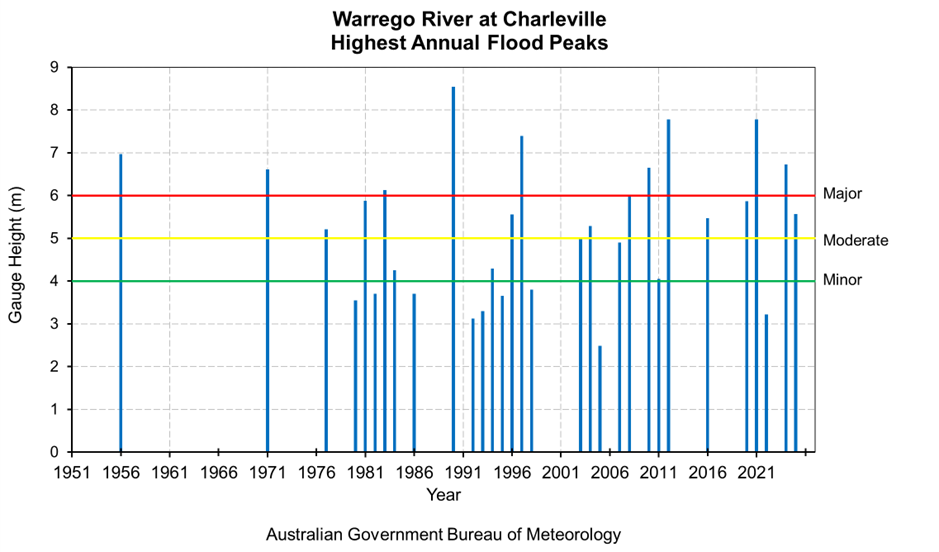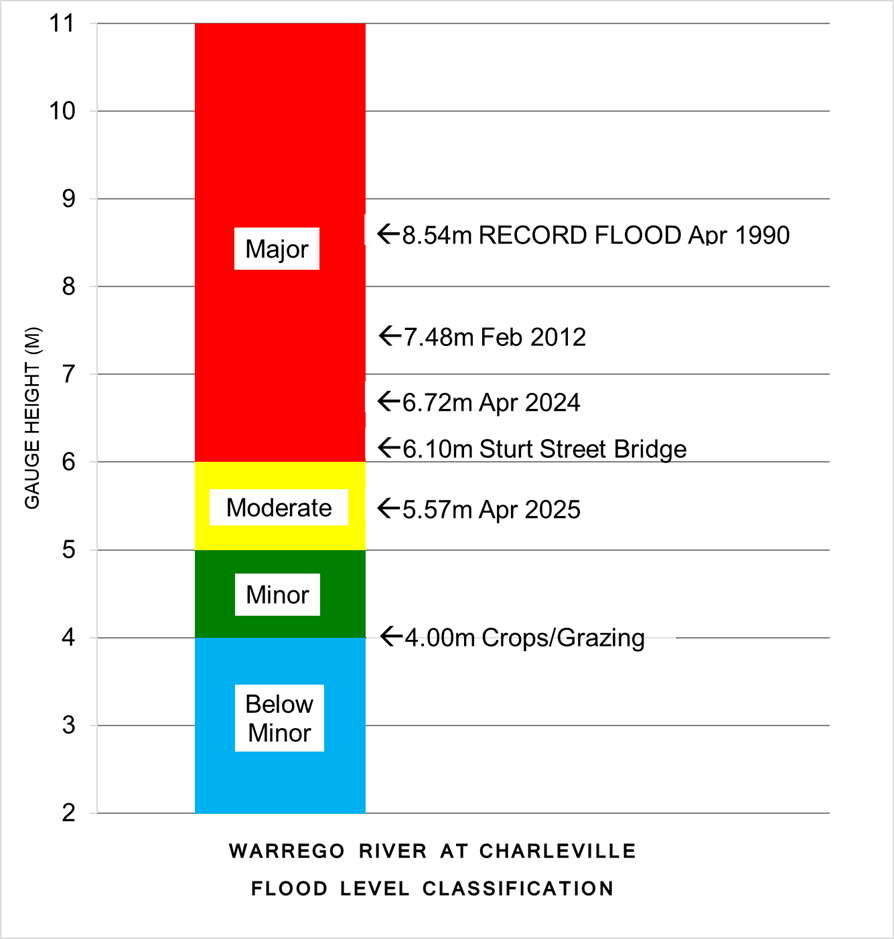This brochure describes the flood risk and previous flooding in the Warrego River catchment, last updated in July 2025.
Flood Risk
The Warrego River catchment is located in southwest Queensland and northwest New South Wales and covers an area of approximately 65,000 square kilometres. The upper Warrego rises in the Carnarvon Ranges, flowing through Augathella, before being joined by major tributary the Nive River south of Augathella. The river then flows through Charleville where it receives inflows from Bradley Creek, before the Ward and Langlo Rivers which drain the western half of the catchment combine and join the Warrego below Charleville. Further downstream and before Bakers Bend, the Warrego River meets the Augelala Creek which drains the western side of the catchment. The Warrego River then flows south past Wyandra and Cunnamulla. During major flood events river flows from the Warrego can breakout overland into the Paroo River around Cunnamulla. While flash flooding may be experienced in upper parts of the catchment, and around Bradley's Gully through Charleville, floods on the Warrego River typically take a number of days to move through the system following heavy rainfall.
Augathella, Charleville and Cunnamulla all have flood mitigation levees in place to reduce the impacts of flooding. In Augathella the levee protects the town up to a level of 7.2m on the flood gauge. In Cunnamulla the township has a levee constructed around the town for flood protection to at least 10.5 metres on the flood gauge. In Charleville, a large levee system around the town has a crest elevation of around 7.9 m on the Warrego River gauge. Charleville also benefits from a creek diversion of Bradley's Gully which aims to redirect flash flooding in Bradley Creek away from the town.
During major flood events, significant inundation of pastoral land, damage to fencing, and disruption to major transport routes occur. While levees around major towns have reduced the impact of major flooding on these communities, levee overtopping is possible if floods of a similar magnitude to 1990 were to occur again.
Previous Flooding
The Warrego River has a well-documented history of flooding with records of the larger floods dating back to 1910. The April 1990 floods remain the flood of record for much of the Warrego River catchment. After several weeks of heavy rain over Queensland, a strong upper level low dumped 150 mm to 350 mm of rain across a three-day period. Floodwaters overtopped the levee and spread through Charleville, necessitating the entire population of 3500 to be evacuated to the airport. Many residents climbed to their rooftops and had to be rescued by helicopters.
More recently in 2012 major flooding occurred again on the Warrego River, with the highest levels since the record 1990 floods for many locations. The levees protected Charleville and Cunnamulla from any significant inundation, but extensive transport impacts occured. The figures below show the significant flood peaks which have occurred at Charleville and Cunnamulla since records began.
| Flood Event | Augathella (m) | Charleville (m) | Bakers Bend (m) | Wyandra (m) | Cunnamulla (m) | Rocky (m) |
| Apr 1956 | - | 6.97 | - | 9.26 | 10.13 | 5.51 |
| Apr 1990 | 7.3 | 8.54 | 12.10 | 10.24 | 10.15 | 5.32 |
| Feb 1997 | 6.4 | 7.39 | 11.09 | 9.86 | 9.78 | 5.23 |
| Jan 2008 | 6.5 | 6.02 | 10.15 | 9.41 | 9.91 | 5.41 |
| Mar 2010 | 5.09 | 6.65 | 10.64 | 9.68 | 10.00 | 5.52 |
| Feb 2012 | 6.77 | 7.78 | 11.40 | 9.95 | 9.98 | 5.45 |
| Feb/Mar 2020 | 3.13 | 5.87 | 9.36 | 8.85 | 9.63 | 5.30 |
| Apr 2024 | 5.69 | 6.72 | 10.16 | 8.99 | 9.59 | 5.30 |
| Mar/Apr 2025* | 1.52 | 5.57 | 9.16 | 8.73 | 9.65 | 5.38 |
All heights are in metres on flood gauges.
*Preliminary values subject to verification




Further Information:
- Latest rainfall and river heights
- For information on the flood warning service for the Warrego River: Queensland Service Level Specification
- Warrego Catchment map: Queensland Warrego,Paroo Rivers map
- National Arrangements for Flood Forecasting and Warning









